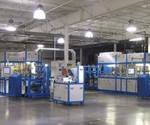Thermoformable thermoplastic composites
Thermoplastic composites that can be shaped into finished parts via thermoforming are proliferating as the thermoforming process gains traction, particularly in aerospace manufacturing. The following short article and chart provide some guidance in terms of sourcing.
This table lists, by supplier, some commercially available thermoformable reinforced thermoplastic composite (TPC) materials. Suppliers use several methods to impregnate fiber reinforcements with thermoplastic polymers.
- Prepregs are made using solvent impregnation or hot-melt impregnation methods similar to those used to make thermoset prepregs. Fibers are wetout during prepreg manufacture,
- Semipregs affix a thin film of the matrix system to a fabric, using heat and pressure. During the forming process, the film or melts and wets out the fabric.
- Powder impregnation coats the fibers or fabrics with the matrix in powder form and then heat-sets it to affix the granulated matrix. During the composite forming process, the powder melts and wets out the fibers.
- Commingled fibers/yarns intermingle the matrix in a fiber form and the reinforcement fiber into a single strand, which then can be processed further to form woven, nonwoven and other textile formats. During the forming process, the TP fibers melt and wet out the fibers.
- Fiber Integrated Thermoplastic (FIT) spreads fiber bundles and then draws them through a wet bath or dry bath of powdered matrix and then closes the bundles, using an extrusion system with the same matrix.
- Self-reinforced polymers are formed from fabrics made with fibers spun from polymer material similar to the liquid matrix with which they are impregnated, but possessing a higher melt-temperature. During processing, the matrix and fibers bond, but the fibers retain some integrity and, therefore, function as a reinforcement.
As the chart indicates, stretch-broken fibers can be used to enable conformability for complex curvature with only a slight knockdown in tensile strength (~85 percent of continuous fiber), as the separate fiber lengths are still maintained in a straight-line load path within the textiles. For more about stretch-broken fibers, click on "Aligned discontinuous fibers-come of age" under "Editor's Picks," at right.
Related Content
-
Manufacturing the MFFD thermoplastic composite fuselage
Demonstrator’s upper, lower shells and assembly prove materials and new processes for lighter, cheaper and more sustainable high-rate future aircraft.
-
MFFD thermoplastic floor beams — OOA consolidation for next-gen TPC aerostructures
GKN Fokker and Mikrosam develop AFP for the Multifunctional Fuselage Demonstrator’s floor beams and OOA consolidation of 6-meter spars for TPC rudders, elevators and tails.
-
Optimizing a thermoplastic composite helicopter door hinge
9T Labs used Additive Fusion Technology to iterate CFRTP designs, fully exploit continuous fiber printing and outperform stainless steel and black metal designs in failure load and weight.













